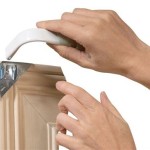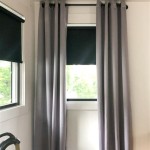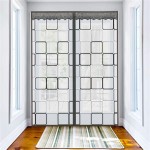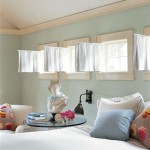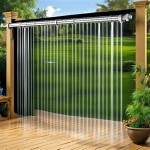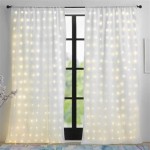Tension Rods for Outdoor Curtains: A Comprehensive Guide
Outdoor spaces are increasingly viewed as extensions of the home. Creating comfortable and aesthetically pleasing outdoor environments often involves the strategic use of curtains. Outdoor curtains offer privacy, shade, and protection from the elements, enhancing the functionality and enjoyment of patios, decks, porches, and gardens. A vital component of any outdoor curtain setup is the hardware used for installation, and tension rods present a versatile and often overlooked solution. This article will explore the use of tension rods for outdoor curtains, examining their benefits, limitations, selection criteria, installation techniques, and maintenance requirements.
Understanding the Benefits of Using Tension Rods
Tension rods provide a compelling alternative to traditional curtain rods that require drilling and permanent mounting. For renters or individuals seeking a non-invasive installation method, tension rods are particularly appealing. The absence of drilling eliminates potential damage to walls, ceilings, or other structural elements, making them suitable for temporary or semi-permanent curtain installations. Furthermore, tension rods offer a high degree of flexibility in terms of placement. They can be easily repositioned or removed as needed, allowing for dynamic adjustments to the outdoor space. This adaptability is especially beneficial for seasonal adjustments, such as removing curtains during winter to maximize sunlight exposure or repositioning them to optimize shade during the summer months.
Another significant advantage is the ease of installation. Unlike traditional curtain rods that often require specialized tools and expertise, tension rods can be installed by individuals with minimal experience. The simple compression mechanism requires no complicated hardware or intricate procedures. This simplicity translates to time savings and reduced installation costs. Furthermore, tension rods are generally more affordable than traditional curtain rod systems, making them an attractive option for budget-conscious homeowners or renters looking to enhance their outdoor living spaces without significant financial investment.
Finally, tension rods are available in a variety of sizes, styles, and finishes, allowing for considerable customization to match the aesthetic of the outdoor area. From sleek and modern designs to more rustic and traditional styles, tension rods can be selected to complement the existing décor and enhance the overall visual appeal of the outdoor space. The wide range of available finishes, including weather-resistant coatings, ensures that the tension rods can withstand the rigors of outdoor exposure while maintaining their aesthetic integrity.
Limitations and Considerations When Using Tension Rods Outdoors
Despite their numerous benefits, tension rods have certain limitations that must be considered before implementation. One primary concern is their weight-bearing capacity. Tension rods rely on friction to maintain their position, and their ability to support heavy curtains, particularly those made from thick or water-resistant materials, is limited. Exceeding the weight limit can lead to slippage or even complete failure of the rod, potentially damaging the curtains and posing a safety hazard. Therefore, it is crucial to carefully calculate the weight of the curtains and select a tension rod with an appropriate weight rating. Lightweight or sheer curtains are generally more suitable for use with tension rods, while heavier fabrics may require alternative support systems.
Another limitation is the suitability of the mounting surface. Tension rods require smooth, stable, and parallel surfaces to maintain a secure grip. Uneven or textured surfaces, such as rough brick or heavily textured stucco, can compromise the rod's ability to generate sufficient friction, leading to instability. Similarly, surfaces that are not perfectly parallel, such as angled walls or ceilings, can make it difficult to achieve a secure and level installation. Careful assessment of the mounting surface is essential to ensure that it is compatible with tension rod installation. In some cases, modifications to the surface, such as the addition of a smooth backing board, may be necessary to provide a suitable mounting point.
Environmental factors also play a crucial role. Outdoor tension rods are exposed to the elements, including rain, wind, sunlight, and temperature fluctuations. These factors can affect the rod's performance and longevity. Prolonged exposure to moisture can lead to corrosion, particularly if the rod is not made from weather-resistant materials. Strong winds can exert significant force on the curtains, potentially causing the rod to slip or even collapse. Sunlight can degrade the finish and weaken the rod over time. Therefore, it is essential to select tension rods specifically designed for outdoor use, featuring weather-resistant materials and coatings that can withstand the rigors of outdoor exposure. Regular inspection and maintenance are also necessary to ensure the rod's continued performance and prevent premature failure.
Selecting the Right Tension Rods for Outdoor Use
Choosing the appropriate tension rod for an outdoor curtain project requires careful consideration of several key factors. The first consideration is material. Tension rods intended for outdoor use should be constructed from weather-resistant materials such as stainless steel, aluminum, or powder-coated steel. These materials offer superior resistance to corrosion and degradation compared to standard steel or plastic rods. Stainless steel is particularly durable and resistant to rust, making it an excellent choice for harsh outdoor environments. Aluminum is lightweight and also offers good corrosion resistance, while powder-coated steel provides a durable and aesthetically pleasing finish. Avoid using tension rods made from materials that are prone to rust or degradation when exposed to moisture and sunlight.
The weight capacity of the tension rod is another crucial factor. Accurately estimate the weight of the curtains that will be hung on the rod. Consider the type of fabric, the size of the curtains, and any additional embellishments. Select a tension rod with a weight rating that exceeds the estimated weight of the curtains to provide a safety margin. Overloading the tension rod can lead to slippage or failure, potentially damaging the curtains and creating a safety hazard. Refer to the manufacturer's specifications to determine the weight capacity of the tension rod and ensure that it is sufficient for the intended application.
The size and adjustability of the tension rod are also important considerations. Measure the distance between the mounting surfaces where the rod will be installed. Select a tension rod that is adjustable within that range. Ensure that the rod can be extended to the desired length without exceeding its maximum extension limit. Overextending the tension rod can weaken its structure and reduce its weight-bearing capacity. Consider purchasing a tension rod with a locking mechanism to prevent slippage and maintain a secure installation. The locking mechanism should be easy to use and provide a reliable means of securing the rod at the desired length.
Finally, consider the style and finish of the tension rod. Choose a tension rod that complements the aesthetic of the outdoor space. Consider the color, design, and overall appearance of the rod. Tension rods are available in a variety of finishes, including brushed nickel, bronze, black, and white. Select a finish that blends seamlessly with the outdoor décor and enhances the overall visual appeal of the space. Consider the visual impact of the tension rod when selecting curtains. Choose curtains that complement the tension rod's style and finish to create a cohesive and aesthetically pleasing look.
Proper Installation Techniques
Successful installation of tension rods for outdoor curtains hinges on following proper techniques. Before beginning, thoroughly clean the mounting surfaces where the rod will be installed. Remove any dirt, dust, grease, or debris that could compromise the rod's grip. Use a mild detergent and water to clean the surfaces, and then dry them completely with a clean cloth. Ensure that the surfaces are smooth and free from any irregularities that could hinder the rod's ability to generate sufficient friction.
Next, carefully measure the distance between the mounting surfaces. Use a measuring tape or ruler to obtain an accurate measurement. Extend the tension rod slightly beyond the measured distance. This will allow for sufficient compression to create a secure grip. Do not overextend the rod, as this can weaken its structure and reduce its weight-bearing capacity. Follow the manufacturer's instructions for adjusting the length of the tension rod.
Position the tension rod between the mounting surfaces. Ensure that the rod is level before applying pressure. Use a level to verify that the rod is horizontal. Adjust the position of the rod until it is perfectly level. Apply gentle pressure to the rod to compress it between the mounting surfaces. Gradually increase the pressure until the rod is firmly in place. Check the rod's stability by gently tugging on it. If the rod slips or moves, increase the pressure until it is securely installed. Avoid applying excessive force, as this can damage the mounting surfaces or the tension rod itself.
Once the tension rod is securely installed, hang the curtains. Ensure that the curtains are evenly distributed along the rod. Avoid overloading the rod with excessive weight. Distribute the weight of the curtains evenly to prevent slippage or sagging. If the curtains are heavy, consider using multiple tension rods to provide additional support. Regularly inspect the tension rod for any signs of slippage or instability. Adjust the pressure as needed to maintain a secure installation.
Maintaining Outdoor Tension Rods for Longevity
Proper maintenance is essential to prolong the lifespan of outdoor tension rods and ensure their continued performance. Regularly inspect the tension rods for signs of rust, corrosion, or damage. Pay particular attention to the joints and the areas where the rod comes into contact with the mounting surfaces. If rust or corrosion is detected, clean the affected areas with a wire brush or sandpaper. Apply a rust-inhibiting primer and a weather-resistant paint to protect the metal from further corrosion.
Periodically clean the tension rods with a mild detergent and water. Remove any dirt, dust, or debris that has accumulated on the surface of the rod. Rinse the rod thoroughly with clean water and dry it with a clean cloth. Avoid using harsh chemicals or abrasive cleaners, as these can damage the finish of the rod. Regular cleaning will help to maintain the appearance of the tension rod and prevent the buildup of dirt and grime.
Tighten the tension rod as needed to maintain a secure grip. Over time, the tension in the rod may decrease due to temperature fluctuations or other factors. Check the rod's stability periodically and adjust the pressure as needed. If the rod is equipped with a locking mechanism, ensure that it is properly engaged to prevent slippage. Regularly inspect the locking mechanism for wear and tear and replace it if necessary.
Protect the tension rods from extreme weather conditions. During periods of heavy rain, snow, or strong winds, consider removing the curtains to reduce the strain on the rod. Store the curtains in a dry and protected location. If the tension rods are not made from weather-resistant materials, consider applying a protective coating to shield them from the elements. By following these maintenance tips, you can extend the lifespan of your outdoor tension rods and ensure their continued performance for years to come.

How To Hang Outdoor Drapes Diy Curtain Rods Polka Dot Chair

Versailles In Outdoor Tension Rod 66 120 Esp Rooms Spaces Canada

Diy Outdoor Curtains 320 Sycamore

Outdoor Curtain Rod Tension Rods Adjustable Closet Telescoping Expandable Shower Replaceable Pole 3 Pcs Wal Com

Outdoor Curtain Rods For Aluminum Screen Room Hometalk

Stainless Steel Spring Tension Curtain Rod With Flare Finial 54 96 Hammacher Schlemmer

Choosing And Hanging Outdoor Curtains The Home

Outdoor Curtain Rod Tension Rods Adjustable Closet Telescoping Expandable Shower Replaceable Pole 3 Pcs Wal Com

How To Make Outdoor Curtain Rods Four Generations One Roof

How To Hang Outdoor Curtains The Cover Blog


